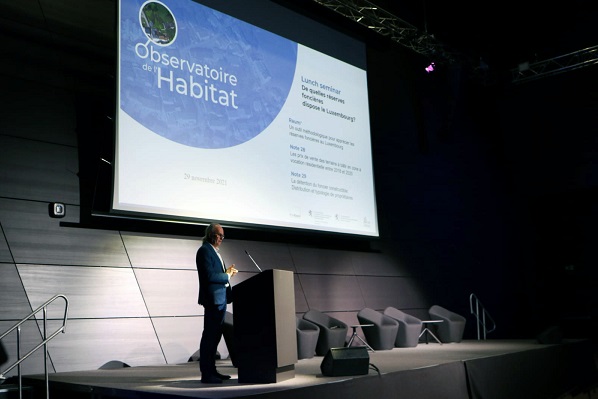 Claude Turmes, Luxembourg's Minister for Energy & Spatial Planning;
Credit: MLOG
Claude Turmes, Luxembourg's Minister for Energy & Spatial Planning;
Credit: MLOG
On Monday 29 November 2021, Luxembourg's Ministry of Energy and Spatial Planning and the Ministry of Housing presented the results of three studies on land potential and its distribution in the Grand Duchy.
Of the 89 municipalities analysed, the land reserve available for housing amounted to 3,750 hectares. It is estimated that 142,000 housing units could be built there for more than 300,000 additional inhabitants. Faced with rising land prices, mobilising this significant building land potential is a top political priority, according to the respective ministries.
The Raum+ methodological tool, which is a joint project of the Department of Spatial Planning's spatial development observatory and the Housing Ministry's habitat observatory, made it possible to establish a territorial, quantitative and qualitative overview of land reserves. So far, a quality census has been carried out with 89 municipalities. With this tool, the Department of Spatial Planning is able to respond to the three main challenges of land use planning: directing and concentrating territorial development in the most appropriate places, observing and monitoring territorial development and ensuring a rational use of the land as well as a concentric and coherent urban development.
The data listed and the analyses carried out constitute a basis for the elaboration of territorial development strategies and targeted measures to mobilise the potential for urbanisation. The analysis carried out determined an availability of 5,018 hectares, of which 64% was in residential areas, 10% was in mixed areas and 15% was in industrial and commercial areas.
“It is interesting to take note of these figures: more than 5,000 ha of land reserves of all kinds with more than 14,500 surfaces have been identified allowing 142,000 new housing units. Even if there are imbalances between certain regions to be developed and the so-called endogenous municipalities, the conclusion of this analysis is quite striking: it is not necessary to enlarge the construction perimeters”, commented Luxembourg's Minister for Spatial Planning, Claude Turmes.
For Minister Turmes, it is now a question of taking this analysis into account and promoting sustainable urban development. “We must limit the consumption of new soil and the fragmentation of the landscape, protect biodiversity and agricultural land and aim for an optimal use of services and infrastructure and a reduction in the costs of servicing and technical infrastructure", he noted.
In this context, Minister Turmes put forward the scenarios and ideas of ecological transition envisaged by the multidisciplinary teams of the international consultation "Luxembourg in Transition" aiming for a carbon neutral Luxembourg by 2050. The four teams' ideas will be presented at the end of January 2022.
The analysis will be completed with the remaining thirteen municipalities and the development of Raum+ will be continued with the identification of the potential for densification and urban renewal, particularly on wasteland, in order to reduce the artificialisation of the soil. Continuous monitoring of this quality methodological tool should also be ensured.
Moreover, the habitat observatory presented the main lessons from the analysis of the sale prices of building land until 2020. The residential land price index created by the observatory showed an annual increase of approximately 7.9% on average between 2010 and 2020. This increase was relatively regular until 2017, after which a strong acceleration was observed, reaching 16.9% between 2019 and 2020. According to the respective ministries, these changes in land prices are consistent with those observed for housing prices (old or under construction), but the increase in land prices tends to be stronger. This suggests that it is the rise in building land prices that largely explains the evolution of house prices, while construction costs had only increased moderately until 2020.
The habitat observatory also noted that the qualitative data from the Raum+ programme show large differences between categories of landowners with regard to their interest in developing land and the time required for construction. Individuals alone could build nearly half of the potential homes on their land, but are the most reluctant to build, argued the ministries. In contrast, according to the estimates of the municipalities, public funds and real estate actors showed a high level of interest in development. According to the two ministries, if the construction of all potential dwellings were started in the next five years, this would lead to an almost doubling of the number of dwellings created per year in the medium term and to the creation of some 20,000 additional dwellings.
The land potential identified through the Raum+ tool in 2020/21 was greater than that identified in 2016. This results from both changes in land allocation and methodological improvements. However, the structure of land ownership has not changed. Private owners still hold the vast majority of building land for residential purposes. On the other hand, the share of the land reserve of natural persons has fallen from 72% to 64% of the total reserve, while that of legal persons (companies) has increased from 15% to 20%.
With the creation of a national land tax intended for the mobilisation of land, an additional instrument will be added to encourage the development of building land.
Luxembourg's Minister of Housing, Henri Kox, concluded: “Knowing that 64.2% of building surfaces for housing are in the hands of private individuals, it is also essential to achieve a change in mentality in Luxembourg society. Private property should not fuel soaring housing prices at the expense of access to affordable housing for a large part of the population. I remind you that 21,000 households spend more than half of their income on housing. This is why high investments in the massive creation of affordable public housing are a priority, and for that the mobilisation of building land is essential!".








